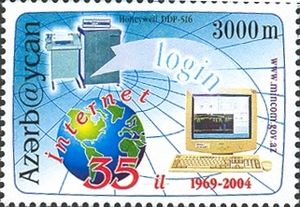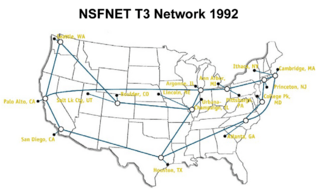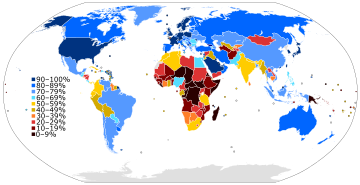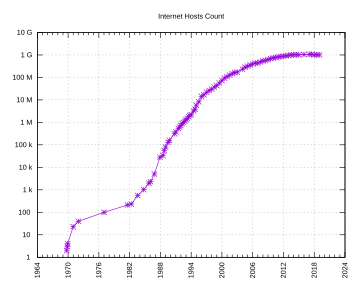History of the Internet facts for kids
The history of the Internet is about how the Internet we use today came to be. It started with smart people trying to connect computers together. The main rules for how computers talk to each other on the Internet, called the Internet Protocol Suite, were developed in the United States. But scientists from places like the United Kingdom and France also helped a lot.
In the late 1950s, computer science was a new field. Scientists started thinking about how many people could use one computer at the same time. Then, they wondered if computers could be connected over long distances. J. C. R. Licklider had the idea of a huge, worldwide network. This was at a special office in the U.S. Department of Defense called ARPA.
Around the same time, Paul Baran suggested a network that would send information in small blocks. And in 1965, Donald Davies came up with the idea of "packet switching" in the UK. This is a way of breaking data into small pieces, called packets, and sending them separately.
In 1969, ARPA started the ARPANET project. It used the packet switching idea from Davies and Baran. Leonard Kleinrock at UCLA did important math work for it. The network was built by a team that included Bob Kahn.
In the 1970s, many early networks started using packet switching. ARPA projects and international groups worked on new rules for connecting different networks. This led to the idea of a "network of networks." Bob Kahn and Vint Cerf published ideas in 1974 that became the Transmission Control Protocol (TCP) and Internet Protocol (IP). These are two main rules of the Internet. Their design included ideas from the French CYCLADES project.
In the early 1980s, public data networks appeared. In the U.S., the National Science Foundation (NSF) helped fund large computer centers at universities. In 1986, the NSFNET project connected these centers. This gave many researchers and schools access to powerful computers. When NSFNET connected with other networks and started using TCP/IP worldwide, the Internet truly began. Companies that provide Internet service (ISPs) started in 1989. The ARPANET was turned off in 1990. By 1995, the NSFNET was also turned off, and commercial companies took over carrying Internet traffic.
In Switzerland, Tim Berners-Lee created the World Wide Web at CERN in 1989–90. This system linked documents together, making information easy to find from any computer. The Internet grew super fast in the mid-1990s with new fiber optic cables. This changed everything! Suddenly, we had instant email, instant messaging, video calls, and the World Wide Web with its discussion forums, blogs, and online shopping. The Internet quickly became the main way people communicate. It keeps growing with more online information, shopping, fun, and social media.
Contents
- How the Internet Began
- Networks That Led to the Internet
- Merging Networks and Creating the Internet (1973–1989)
- Rise of the Global Internet, Web 1.0 (1990–2003)
- Web 2.0 and Global Internet (2004–Present)
- How the Internet is Managed
- The Internet and Society
- How We Use the Internet
- Online Piracy
- Growth in Demand
- Images for kids
- See also
How the Internet Began
Early Ideas
The idea of sending data between two different places, like through radio or wires, existed before computers. Early systems like the telegraph sent messages. The telegraph was the first fully digital communication system in the late 1800s.
Scientists like Claude Shannon developed "information theory" in the 1940s. This helped us understand how to send information clearly, even with noise. This, along with new technology like transistors and lasers, helped telecommunications grow quickly.
Early computers in the 1940s were used by one person at a time. As computers got better, people wanted to connect them over longer distances. This made it possible to share files between computers. But these connections were usually only between two specific computers. If a link broke, there was no other way for the information to go. This was a problem, especially for military use.
The Visionaries
Christopher Strachey first thought about "time-sharing" in 1959. This meant many users could share one computer at the same time. He shared this idea with J. C. R. Licklider. In 1960, Licklider wrote about a "network of such centers, connected to one another by wide-band communication lines." He imagined a future where libraries and information were all linked.
In 1962, Licklider started working at DARPA. He wanted to connect the U.S. Department of Defense's main computers. He wrote memos about a "Intergalactic Computer Network." Even though he left DARPA before ARPANET started, his vision pushed others to create it.
Packet Switching: A Key Idea
Connecting different networks was a big challenge. Old networks used "message switching," which meant if one link broke, the whole message might not get through. In the 1960s, Paul Baran studied how to make military networks survive a nuclear war. He suggested dividing information into "message blocks."
At the same time, Donald Davies in the UK came up with "packet switching." This is the term we use today. Packet switching breaks messages into small pieces (packets). Each packet can take a different path to its destination. This makes networks faster and more reliable. If one path is busy or broken, the packets can find another way.
Networks That Led to the Internet
The NPL Network
After talking with Licklider, Donald Davies became very interested in computer networks. In 1965, he designed a national data network for the UK based on packet switching. He also described using an "Interface computer" as a router. This proposal wasn't chosen for the whole country. But Davies built a local network at the NPL to show that packet switching worked.
His team was one of the first to use the word "protocol" for data communication in 1967. The NPL network and ARPANET were the first two networks in the world to use packet switching. The NPL network was the first to use very fast connections.
ARPANET: The Beginning
Robert Taylor took over Licklider's office at DARPA in 1966. He wanted to make Licklider's idea of connected networks real. Taylor noticed that he had three different computer terminals, each with different commands. He thought, "It's obvious what to do: If you have these three terminals, there ought to be one terminal that goes anywhere you want to go." This idea became the ARPANET.
Taylor brought in Larry Roberts to lead the project. Roberts learned about packet switching from Davies and Baran. He added these ideas to the ARPANET design, making it much faster. Leonard Kleinrock then developed the math to make sure this technology worked well.
The first ARPANET link was made on October 29, 1969. It connected UCLA and the Stanford Research Institute (SRI).
"We set up a telephone connection between us and the guys at SRI ...", Kleinrock ... said in an interview: "We typed the L and we asked on the phone,
"Do you see the L?"
"Yes, we see the L," came the response.
We typed the O, and we asked, "Do you see the O."
"Yes, we see the O."
Then we typed the G, and the system crashed ...
Yet a revolution had begun" ....
By December 1969, ARPANET had four connected computers. In the same year, Taylor helped fund ALOHAnet, which sent data by radio between computers in Hawaii.
Steve Crocker started a "Networking Working Group" in 1969. ARPANET development used a process called "Request for Comments" (RFCs), which is still used today for Internet standards. The first RFC was published on April 7, 1969.
In 1973, ARPANET connected to Norway and to Peter Kirstein's group in London. This created the first international network that shared different types of resources. By 1981, ARPANET had 213 connected computers. It became the main part of what would become the Internet.
Merit Network
The Merit Network started in Michigan in 1966. It aimed to connect three public universities. The first connection was made in December 1971 between the University of Michigan and Wayne State University. This network grew to support many types of connections and eventually used TCP/IP. Merit Network played a big role in the later NSFNET project.
CYCLADES Network
The CYCLADES network was a French research network led by Louis Pouzin. It explored new ideas for network design. It was the first network to make the computers responsible for sending data reliably, not the network itself. This idea influenced the design of TCP/IP.
X.25 and Public Networks
Based on international research, new network standards like X.25 were created in the 1970s. X.25 was like a virtual phone line for data. In 1974, X.25 was used for the SERCnet network in the UK, which later became JANET. Many public data networks around the world adopted X.25.
In 1978, the first international packet-switched network, IPSS, was created. It grew from Europe and the U.S. to cover Canada, Hong Kong, and Australia by 1981. Unlike ARPANET, X.25 was often available for businesses.
Early public networks allowed users to dial in with their computers. In 1979, CompuServe was the first to offer email to personal computer users. In 1980, it offered real-time chat. Other big dial-in networks were America Online (AOL) and Prodigy. Many bulletin board systems (BBS) also offered online access.
UUCP and Usenet
In 1979, two students at Duke University, Tom Truscott and Jim Ellis, found a way to share news and messages using UUCP connections. After they released their software in 1980, the Usenet news network grew very quickly. UUCP networks spread because they were cheaper and could use existing phone lines. By 1981, there were 550 UUCP computers, almost doubling to 940 by 1984.
Merging Networks and Creating the Internet (1973–1989)
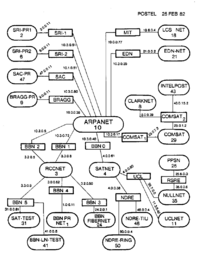
TCP/IP: The Internet's Language
With so many different networks, a way to connect them all was needed. Louis Pouzin's CYCLADES project helped. An international group formed in 1972, including Vint Cerf and Bob Kahn. They realized that the network itself didn't need to be responsible for making sure data arrived reliably. Instead, the computers sending and receiving the data could handle that.
Kahn and Cerf published their ideas in 1974. The rules they created were called the Transmission Control Program. It was the first time the word "internet" was used as a short form for "internetwork." This new design made it possible for different networks to talk to each other easily.
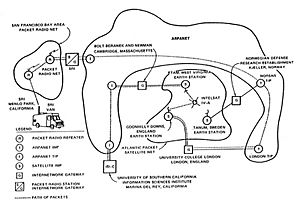
Testing began in 1975. On November 22, 1977, a big demonstration connected ARPANET, a Packet Radio Network, and a Satellite Network.
The software was later split into two parts: the Transmission Control Protocol (TCP) and the Internet Protocol (IP) in 1978. This became known as TCP/IP. The U.S. Department of Defense made TCP/IP the standard for all military computer networking in 1983. This helped TCP/IP become widely used.
From ARPANET to NSFNET
After several years, ARPANET was handed over to the Defense Communications Agency in 1975. In 1983, the military part of ARPANET became a separate network called MILNET.
The early ARPANET-based networks were government-funded and only for research. Commercial use was not allowed. This meant only military sites and universities could connect. In the 1980s, more schools connected, and companies involved in research also joined.
Other U.S. government groups, like NASA and the NSF, also got involved. They developed their own wide area networks using TCP/IP. NASA created the NASA Science Network. NSF created CSNET.
In 1981, NSF supported the Computer Science Network (CSNET). CSNET connected to ARPANET and helped make the Internet popular outside of ARPANET.
In 1986, the NSF created NSFNET, a fast network to support supercomputer centers. It also helped connect universities and colleges. The NSFNET quickly became very busy. In 1988, it was upgraded to be even faster. Because of NSFNET, ARPANET was turned off in 1990.
When NSFNET was turned off in 1995, its fast fiber optic lines were given to commercial Internet companies. This helped these companies carry more Internet traffic. Today, research and academic groups still use advanced networks like Internet2.
The Internet Goes Global (1980s)
The term "internet" became the name for the large, global TCP/IP network when ARPANET connected to NSFNET in the late 1980s.
The demand for Internet capacity grew as more businesses and people wanted to connect. New technologies like "wave division multiplexing" (WDM) helped send much more data over fiber optic cables. This was a big step for optical networking.
Internet technologies spread worldwide because TCP/IP could work with existing network setups. Many places that couldn't connect directly to the Internet used simple ways to send email.
Finally, new routing technologies like the Border Gateway Protocol (BGP) made the Internet less centralized. This meant there was no single point of control.
CERN and the European Internet
In 1982, groups in Norway and London started using TCP/IP. The London group continued to connect ARPANET to academic networks in the UK.
Between 1984 and 1988, CERN in Switzerland started using TCP/IP for its internal computer systems. There was some resistance in Europe to using TCP/IP widely. CERN's TCP/IP networks stayed separate from the Internet until 1989, when they made a connection to Cornell University in the U.S.
In 1988, the first international connections to NSFNET were made from France and the Netherlands. This helped the European part of the Internet grow. In January 1989, CERN opened its first external TCP/IP connections.
The Link to the Pacific
South Korea set up its own TCP/IP network in 1982. It connected to the world in 1983 and formally to NSFNET in 1990.
Japan connected its JUNET network to CSNET and then to NSFNET in 1989. This marked the spread of the Internet to Asia.
In Australia, universities started connecting to ARPA and each other in the late 1980s. In 1989, Australian universities decided to use IP protocols to connect their networks. AARNet was formed to provide a dedicated IP network for Australia. New Zealand also connected to the U.S. in 1989.
The "Digital Divide"
While developed countries joined the Internet, developing countries faced a "digital divide." This meant they had less access to the Internet. Organizations were built to help these regions get more Internet access.
Africa
In the early 1990s, African countries mostly used slower connections for computer communication. In August 1995, Uganda got Africa's first high-speed satellite Internet service. It was a 64 kbit/s connection.
In 1996, a project called the Leland Initiative helped African countries get full Internet access. Countries like Guinea and Mozambique got satellite stations in 1997. Africa is still building its Internet infrastructure.
Asia and Oceania
The Asia Pacific Network Information Centre (APNIC) manages IP addresses for this region.
In South Korea, VDSL technology helped connect homes and businesses to the Internet using phone lines.
China made its first global Internet connection in 1994. However, China also started to filter Internet content across the country.
Japan hosted a big Internet meeting in 1992. Singapore developed TECHNET in 1990, and Thailand got a global Internet connection in 1992.
Latin America
The Latin American and Caribbean Internet Addresses Registry (LACNIC) manages IP addresses for its area. It helps with key Internet services.
Rise of the Global Internet, Web 1.0 (1990–2003)
At first, the Internet was mainly for government and research. Commercial use was not allowed. But the rules were unclear. Companies like PSINet and UUNET started in the late 1980s to provide Internet services to the public. In 1989, MCI Mail was the first commercial email provider to connect to the Internet. The first commercial dial-up Internet service provider (ISP) in the U.S. was The World, which opened in 1989.
In 1992, the U.S. Congress allowed the NSF to support connections between research networks and commercial networks. This led to some debate.
By 1990, ARPANET had achieved its goals and was shut down. New companies were offering Internet access to businesses. The NSFNET was no longer the main backbone. On April 30, 1995, the National Science Foundation stopped funding the NSFNET Backbone Service. This removed the last rules against commercial traffic.
Internet Use in Wider Society
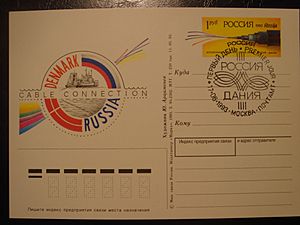
The invention of the World Wide Web by Tim Berners-Lee at CERN brought many social and business uses to the Internet. The Web opened to the public in 1991 and became widely used in 1993-94.
In the early days of the public Internet, things were very different. Smartphones didn't exist. Social media as we know it wasn't around. Laptops were big, and most homes didn't have computers. Internet speeds were slow.
The Internet was used for mailing lists, emails, early online shopping (like Amazon and eBay), online forums, and personal websites. It was growing fast, but it wasn't as interactive as today. It took a few more years for the Internet to become a key part of global society.
Websites from this "Web 1.0" era often had static pages. They used simple HTML and forms that sent information by email.
Between 1997 and 2001, there was a "dot-com bubble." Many Internet companies had very high stock values, followed by a market crash. But this only slowed growth for a short time. The Internet quickly recovered and kept growing.
IPv6: More Addresses for Everyone
The last available IPv4 address was given out in January 2011. IPv4 uses 32-bit addresses, which means it can only have about 4.3 billion unique addresses. This might sound like a lot, but with so many devices connecting to the Internet, we ran out!
IPv4 is being replaced by IPv6, which uses 128-bit addresses. This provides a huge number of addresses, enough for everything imaginable. The change to IPv6 will take many years because there are so many devices using IPv4.
Web 2.0 and Global Internet (2004–Present)
The Internet changed very quickly between 2005 and 2010. It became a social system that changed how people interact. This happened because of several things:
- The idea of "Web 2.0" in 2004.
- More homes getting computers and people becoming familiar with them.
- Storage technology and data speeds getting much faster. Hard drives grew from megabytes to gigabytes and then terabytes. Internet speeds went from kilobits to gigabits per second.
- Faster Internet and wider coverage at lower prices.
- People realizing how computers could create new ways to communicate. This led to the rise of social media like Twitter and Facebook, and global projects like Wikipedia.
- The mobile device revolution. Smartphones and tablets became common, giving almost everyone easy Internet access. People could share, discuss, and get information anywhere.
- Better and cheaper memory for small devices.
- Focus on power-efficient processors, which helped companies like ARM become leaders in mobile devices.
"Web 2.0" describes websites that focus on content created by users, ease of use, and working well with other sites. It first appeared in 1999. In 2004, Tim O'Reilly and Dale Dougherty helped make the term popular. They said the Web became a "platform" where users help build the business by creating content.
Web 2.0 isn't a technical update. It's about how web pages are made and used. Sites now let users interact and work together, creating content in online communities. Examples include social networks, blogs, wikis, and video sharing sites. This era saw companies like YouTube, Twitter, Facebook, and Wikipedia become very popular.
The Mobile Revolution
The "Web 2.0" changes were sped up by the growth of mobile devices. Smartphones became something many people carried everywhere. They used them to communicate, take photos and videos, shop, and get information on the go.
Location-based services became common. Websites and services knew where you were. Mobile-friendly websites became popular. The term "App" (short for Application) appeared, along with "App stores."
This "mobile revolution" gave people a huge amount of information at their fingertips. It changed how we use media. Most young people now use smartphones for media.
Networking in Outer Space
The first Internet link to low Earth orbit happened on January 22, 2010. Astronaut T. J. Creamer sent the first unassisted tweet from the International Space Station. This showed the Internet reaching into space. Astronauts can now use a station laptop to control a computer on Earth and talk to their families.
NASA and Google are working on a new network protocol called Delay-tolerant networking (DTN) for spacecraft beyond Earth. DTN helps send data even if connections are temporarily lost. NASA tested this "deep space internet" in 2008. This technology will help missions with multiple spacecraft communicate with each other and with Earth.
How the Internet is Managed
The Internet is a huge network of many smaller networks. It doesn't have one central boss. Each network chooses its own technology. But to work together, some things need to be the same.
The Internet Assigned Numbers Authority (IANA) helps manage technical numbers and names for the Internet. The Internet Corporation for Assigned Names and Numbers (ICANN) oversees the main naming systems, like IP addresses and domain names.
Early Management and ICANN
At first, a group at USC managed IANA. As the Internet grew, it became too much for one place. In 1983, the Domain Name System (DNS) was created to make naming easier.
In 1993, the U.S. National Science Foundation created the InterNIC to manage addresses and databases. Over time, it was decided that managing domain names should be separate from managing IP numbers. Regional Internet Registries (RIRs) were set up around the world to manage IP addresses for their regions.
In 1998, IANA and other DNS functions were moved under ICANN. ICANN is a non-profit group that helps coordinate the Internet's technical parts. ICANN became fully independent from the U.S. government in 2016.
Internet Engineering Task Force (IETF)
The Internet Engineering Task Force (IETF) is a large group of volunteers from around the world. They help develop new Internet standards. They work in "Working Groups" to create these standards. The IETF doesn't control the Internet, but its work is very important.
The IETF started in 1986. Non-government people were invited in 1986. By 1992, the Internet Society was formed, and the IETF started working under it as an independent group. The IETF meets three times a year, and many attendees are from outside the U.S.
Request for Comments (RFCs)
Request for Comments (RFCs) are the main documents for the IETF's work. RFC 1 was written in 1969, before the IETF existed. RFCs cover many topics, from proposed standards to historical information. They are written by individuals or working groups. Once an RFC is published, it is never changed. If a standard changes, a new RFC is published that replaces the old one.
The Internet Society (ISOC)
The Internet Society (ISOC) is a non-profit group founded in 1992. Its goal is "to assure the open development, evolution and use of the Internet for the benefit of all people throughout the world." ISOC supports the IETF and other groups that set Internet standards. It also promotes the Internet's open and transparent way of working.
Internet Governance in the 21st Century
Since the 1990s, how the Internet is managed has become very important to governments, businesses, and people. The groups that control technical parts of the Internet are now watched more closely by the world.
In 2005, a meeting in Tunis called for an Internet Governance Forum (IGF). The IGF is a place for governments, businesses, and others to talk about the future of Internet governance.
Tim Berners-Lee, who invented the Web, launched the World Wide Web Foundation (WWWF) in 2009. He wanted to make the Web a safe and helpful tool for everyone. In 2019, he launched the Contract for the Web, asking governments and companies to commit to principles to stop the Web from being misused.
The Internet and Society
The Internet has become a very important way for people to communicate. This has led to many activities moving online.
Examples include:
- Political activities like protests and asking for votes.
- Sharing ideas and opinions.
- Finding followers for ideas, products, or causes.
- Sharing sensitive information (and efforts by some countries to stop this through censorship).
- Criminal activity and terrorism (and law enforcement's use of the Internet, sometimes with mass surveillance).
- Politically motivated fake news.
Net Neutrality
Net neutrality is the idea that Internet service providers (ISPs) should treat all data on the Internet equally. This means they shouldn't block or slow down certain websites or charge extra for faster access to some content.
In 2014, the Federal Communications Commission (FCC) in the U.S. thought about allowing ISPs to offer faster lanes for content. This would have gone against net neutrality. Many people, including President Obama, wanted the FCC to keep net neutrality.
On February 26, 2015, the FCC voted to support net neutrality. The FCC chairman, Tom Wheeler, said this was "no more a plan to regulate the Internet than the First Amendment is a plan to regulate free speech." However, on December 14, 2017, the FCC reversed this decision.
How We Use the Internet
Email and Usenet
Email is often called the "killer application" of the Internet because it was so useful. It existed before the Internet and was key to creating it. Email started in 1965 as a way for many users on one computer to talk to each other.
In 1971, Ray Tomlinson created the standard email address format using the @ sign. Email could be sent between many different networks.
UUCP also allowed people to publish text files that many others could read. This grew into discussion groups called newsgroups. On ARPANET, similar groups formed through mailing lists, discussing everything from technical issues to science fiction.
In the early Internet days, email was also used to get files that weren't directly online. For example, people could send email commands to get files, which would then be sent back in pieces by email. This was the only way for some people to download things like early Linux versions using slow dial-up connections.
File Sharing
Sharing files has been important on computer networks for a long time. Tools like bulletin board systems (1978) and Usenet (1980) helped. The File Transfer Protocol (FTP) for the Internet was standardized in 1985 and is still used today. Other tools like Gopher and Archie helped people find files.
In 1999, Napster became the first peer-to-peer file sharing system. Napster used a central server to find files, but the files themselves were stored and shared directly between users' computers. Many other file-sharing programs followed, like Gnutella and BitTorrent.
These tools can share all kinds of content, but music, software, and movies are major uses. While some sharing is legal, much of it is not. Lawsuits have caused many file-sharing services to shut down or change. File sharing remains a debated topic, with arguments about intellectual property theft versus censorship.
File Hosting Services
File hosting lets people store their files on a server, expanding their computer's storage. Most services offer free storage and more for a fee. These services have greatly expanded the Internet for both business and personal use.
Google Drive, launched in 2012, is very popular. It lets users store, edit, and share files. It also includes free office programs like Google Docs. This is very useful for students and anyone needing cloud storage.
Dropbox, released in 2007, is similar. It keeps files in a folder on your computer synced with Dropbox's servers. Mega is another large service, with over 200 million users, focusing on privacy and encrypted storage.
Online Piracy
The first online piracy started with Napster in 1999, a music sharing service. Sites like LimeWire, The Pirate Bay, and BitTorrent allowed anyone to share copyrighted material. This changed the media industry a lot.
Mobile Phones and the Internet
Global mobile data traffic has grown hugely, increasing 150 times from 2010 to 2020. Smartphones account for most of this traffic, with video being a big part. This mobile traffic travels through cell phone towers and then over high-capacity fiber optic networks. These networks support many mobile services, including the Internet of Things, virtual reality, and gaming.
The most popular mobile phone app is texting. The first text message was sent on December 3, 1992.
The first mobile phone with Internet was the Nokia 9000 Communicator in 1996. But Internet access on phones was limited until prices dropped and networks improved. NTT DoCoMo in Japan launched the first mobile Internet service, i-mode, in 1999. In 2001, BlackBerry launched its mobile email system.
A special design for mobile devices, the Wireless Application Protocol (WAP), was created for small screens and keypads. Most mobile Internet services use WAP. Mobile Internet use grew fastest in Asia first, then in developing countries. In Europe and North America, growth was slower because many people already had computers. But in 2008, more Internet devices were mobile phones than personal computers.
Growth in Demand
Global Internet traffic continues to grow very fast. In 2021, there were 4.66 billion active Internet users, which is half the world's population. This demand for data is expected to keep increasing. This huge capacity comes from optical networking systems, which use lasers and fiber optic cables. These systems are installed all over the world. The Internet keeps growing because of new users, more mobile phones, connected homes, 5G devices, and the need for cloud services like Amazon, Facebook, and YouTube.
Images for kids
See also
 In Spanish: Historia de Internet para niños
In Spanish: Historia de Internet para niños


